|
Preface
Whether it's a product I develop
myself or a project that I consult with a client,
architecture has always been one of the most important
things I do. At first, it was software architecture,
then system architecture, and then more and more,
it involved a larger architecture scope: business,
data, applications, and technology. At this time,
the complete architecture system provided by enterprise
architecture is very helpful for my architecture work.
In 2011, he provided business modeling and business
architecture design training and consulting for a
project in Zhejiang Province, and felt that the combination
of business and IT is a complete view of the information
system. In 2017, as a consultant, he provided IT top-level
design consulting for a provincial financial cloud,
and designed the business architecture, data architecture,
application architecture and technical architecture
for the customer's financial cloud project based on
the enterprise architecture. I deeply feel that enterprise
architecture is very important for the service-oriented
integration of IT systems that has lasted for many
years, and can bring different orders of magnitude
of effect to the cost, efficiency and quality of construction.
Therefore, it specializes in providing consulting
services for the design of IT top-level architecture
for enterprises and government units, and the following
is a screenshot of the IT top-level architecture planning
based on cloud computing architecture for an enterprise:
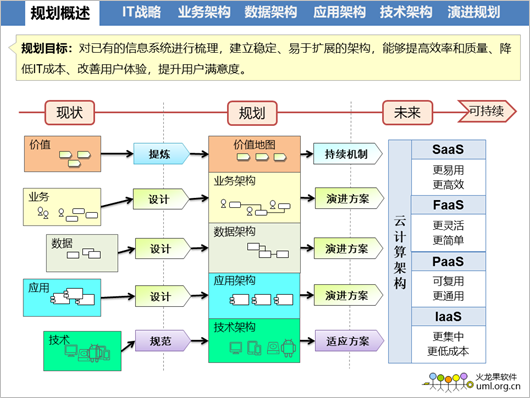 |
| Screenshot
of the IT top-level design scheme |
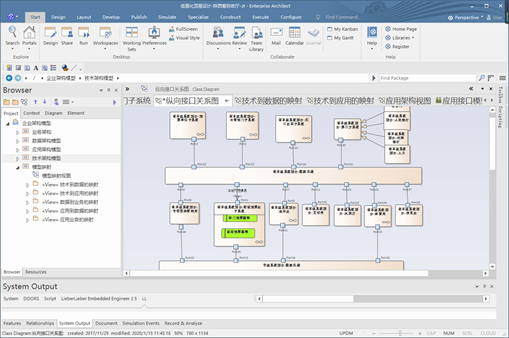 |
| Enterprise
architecture model built with EA |
In October 2019, the Dragon Fruit
Software Engineering Technology Center officially
became Open A member of the TOGAF Chapter of the Group,
the certification training course "Building
Enterprise Architecture on TOGAF". Enterprise
architecture involves architecture, development methods,
modeling languages, principles, and many other contents,
which often make learners feel confused and confused
The "Introduction to TOGAF and Enterprise Architecture"
chapter selects some content in the hope that readers
can understand the basic concepts and relationships
of enterprise architecture, TOGAF, ArchiMate, etc.
Body
Now, with the close support of
enterprise information system to business and the
continuous accumulation of complexity and quantity
of information system, there are more and more information
systems, and it is urgent to establish a view of IT
top-level architecture design in order to provide
framework guidance for the continuous development
of IT systems.
From the perspective of an enterprise
as a whole, enterprise architecture is an effective
way to guide the top-level design of IT based on IT
technology and business-oriented to achieve the value
goals of the enterprise.
There are 2 key words that should
be noted in the definition of enterprise architecture:
Enterprise: It should be
oriented to the whole enterprise, or at least run
through the entire enterprise from a certain level,
so as to have an enterprise-level vision and solve
enterprise-level problems; This also shows that
the boss of the enterprise needs to understand and
participate and support.
Architecture: It should be
oriented to the main problem and the main solution,
and it should be framework, not trivial; The architecture
should be space-oriented to the whole, temporally
oriented to the long-term, and position-oriented
to strategy, rather than layout-oriented, short-term,
and can be adjusted at will.
To learn enterprise architecture,
we should first start with the basic concepts of enterprise
architecture, so that we can clearly understand the
starting point of enterprise architecture, know the
relationship between enterprise architecture and your
current IT projects, and then think about how to combine
enterprise architecture with your own work.
After understanding the concept
of enterprise architecture, it is necessary to understand
the content of enterprise architecture, Enterprise
architecture generally includes: enterprise strategy,
business architecture, data architecture, application
architecture, technical architecture, in which data
architecture and application architecture are also
combined to be called information architecture, that
is, information systems generally include data and
application 2 parts.
The above description is still
more conceptual, in order to make the reader see clearly,
here is a brief example to give you an overview of
the form and content of enterprise architecture, here
is modeled using the five-level view of the enterprise
architecture modeling language ArchiMate.
Enterprise architecture is destined
to be a complex system engineering because of the
strategy, business and IT of the whole enterprise,
if you want to implement enterprise architecture,
you should generally consider the following aspects:
Architecture
modeling
|
The
standard approach to enterprise architecture modeling
is to use the modeling standards provided by ArchiMate,
which is divided into 6 levels (strategic, business,
application, technical, physical, implementation
and migration) from a professional perspective,
and each level can be divided into 4 aspects (motivation,
active structure, behavior, and passive structure)
according to the content, and the 6 levels and
4 aspects are mapped to each other. |
| Architecture
development process and methodology |
The
Architecture Development Methodology (ADM) divides
the enterprise architecture development process
into 9 phases (Preparation, Architecture Prospect,
Business Architecture, Information Systems Architecture,
Technology Architecture, Opportunities & Solutions,
Migration Plan, Implementation Governance, and
Architecture Management). |
| Architectural
principles |
The
design of the architecture should be pre-set principles,
so that the designer can grasp the direction of
the architecture from the beginning, and the design
principles of the architecture are common There
are five aspects: quality principle, business
principle, data principle, application principle
and technical principle. |
| Schema
content |
What
the architecture submits to the user is the
core part of the architecture, and the content
of the architecture should be clear to the users
in 3:
Clarify the meta-model of the architecture from
the perspective of the architecture designer
as the basis for architecture design.
From the perspective of architecture developers,
the input and output of each stage of the architecture
are clarified as intermediate products of architecture
development.
Define the final deliverables from the perspective
of the architecture users as the results of
the external delivery of the architecture. |
Architecture
quality standards
|
The
quality of the architecture needs to establish
corresponding standards, and corresponding evaluation
indicators, evaluation methods, and measurement
methods should be established for the artifacts
and deliverables of the architecture. |
| Architectural
examples |
In
order to be universal, architecture specifications
generally do a lot of abstractions from a general
point of view, so that the reference seems difficult
to understand, and the use of the landing feels
unreliable, architecture examples can be from
a specific architecture design example, so that
readers can understand the vivid story of architecture,
the real growth process of understanding. Because
of the high complexity of enterprise architecture,
there are not many successful implementations,
and because enterprise architecture involves the
core knowledge assets of the enterprise, so there
are few public references in this regard. |
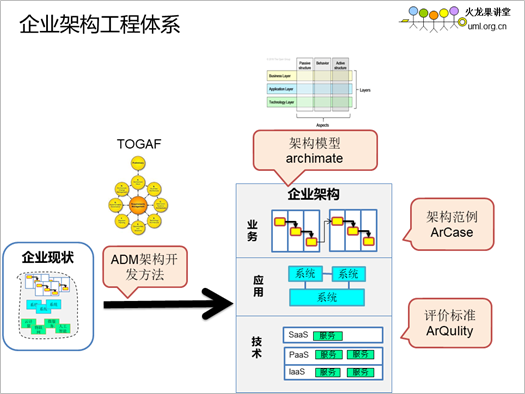 |
Let's take a look at each of the
enterprise architecture specifications that have just
been raised: ArchiMate and TOGAF. First, let's take
a look at TOGAF.
TOGAF is positioned to provide
solutions for enterprise architecture, so let's take
a look at what TOGAF has to offer through TOGAF's
canonical blueprint:
As can be seen from the blueprint
of TOGAF's canonical structure in the figure above:
TOGAF
is positioned as Business Vision Driven TOGAF
helps build business capabilities, and the practice
of business capabilities creates new business
needs, and the three are constantly iterating
and promoting the continuous growth of the enterprise.
The core content of TOGAF is as follows:
Architecture Capability
Framework
Architecture development
methodology
Schema Content Framework
Business continuity and
tools |
The most important part of TOGAF
is the Architecture Development Methodology (ADM),
let's take a look at the 1 core and 9 phases of ADM,
as shown in the figure below:
One core is: requirements management,
as a way to carry through all phases of the enterprise
architecture process. The 9 stages are£∫
1. Preparatory phase
2. Architecture Prospect Stage
3. Business architecture phase
4. Information system architecture stage
5. Technical architecture phase
6. Opportunity & Solution Phase
7. Migration planning phase
8. Implement the governance phase
9. Architecture Change Management Phase
The establishment of enterprise
architecture is not a matter of 1 or 2 years, because
it involves a wide range, is related to the overall
foundation, and has great responsibilities, so it
is destined to be the long-term pursuit of an enterprise,
which needs to be gradually built, iteratively carried
out, and adhered to for a long time. And this process
should not be quick success, but should be held in
pursuit of excellence, enjoy the growth of the mindset,
set positive goals, continue to find problems, solve
problems, step by step.
Because only by knowing what the
content is, the development of enterprise architecture
can really be implemented, so after a general understanding
of the basic concepts of enterprise architecture and
TOGAF's architecture development methodology, More
attention should be paid to how to model the enterprise
architecture, so that the complex enterprise architecture
can be communicated, understood and used by most people
in a visual model. When it comes to building the enterprise
architecture at a deeper level, ArchiMate plays a
greater role TOGAF is also important.
ArchiMate clearly defines the
6 levels of enterprise architecture through modeling
guidelines£∫
Strategic layer: Specify the
strategic goals and growth roadmap of the enterprise
architecture.
Business Layer: The source
of the driving force for enterprise architecture.
Application layer: the organization
and integration of information systems that support
business.
Technology layer: The network,
software, and hardware technologies on which applications
are built.
Physical layer: The physical
devices and networks that support the application.
Implementation & Migration:
Project process control for the implementation of
enterprise architecture.
4 aspects of ArchiMate£∫
Motivation: What are the reasons
for the enterprise architecture design and improvement
goals.
Active structure: The agent
who initiates various actions.
Behavior: The activities that
provide the various capabilities and the processes
that they make up and the services that they fulfill.
Passive structure: The various
objects that are processed.
There is a mapping between ADM,
which is the architecture development process, and
ArchiMate, which describes the architecture, as follows:
The ArchiMate modeling view for
each phase of ADM is as follows:
The Preparatory and Architectural
Prospect phases are modeled using ArchiMate's Strategy
& Motivation layer°£
The business architecture phase
is modeled using ArchiMate's business layer.
The information system architecture
phase is modeled using ArchiMate's application layer.
The technology architecture
phase is modeled using ArchiMate's technology layer.
The Opportunity & Solution
Phase, Migration Planning Phase, and Implementation
Governance Phase are modeled using ArchiMate's Implementation
& Migration layer.
Requirements management is
a through-line effort that involves modeling at
all levels.
The architecture change management
phase is also involved in virtually all levels of
modeling.
Having said that, the enterprise
architecture reference framework TOGAF and the modeling
specification ArchiMate need strong tool support,
and EA needs to be supported by TOGAF, ArchiMate,
and Zachman The framework provides complete modeling
support, as shown in the screenshot of the interface:
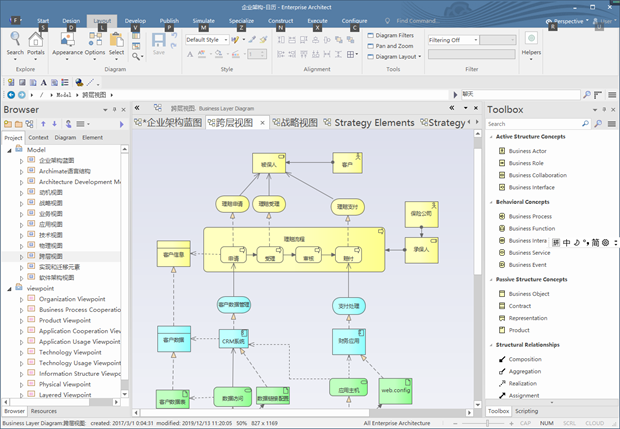 |
| An example
of ArchiMate modeling for EA |
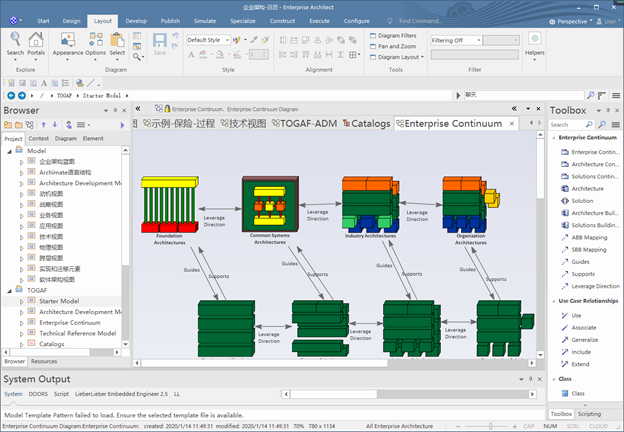 |
| EA's TOGAF
Enterprise Continuity Modeling |
DoDAF (United States Department
of Defense Architecture Framework) serves as a specific
reference framework for enterprise architecture in
the military field, giving specific architectural
references from eight views.
8 views of DoDAF:
1. Full view
2. Data & Information View
3. Standard view
4. Capability view
5. Combat view
6. Service View
7. System View
8. Project View
These provide a tracking view
of the relevant modeling and various models in the
EA, as shown in the following image:
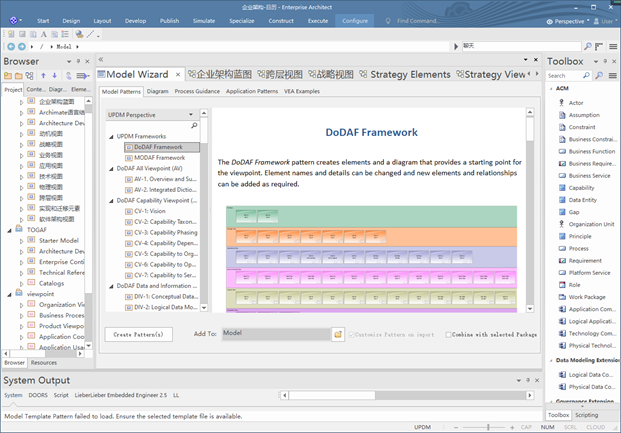 |
| DoDAF model
framework in EA |
If you want to learn more about
Enterprise Architecture, TOGAF, and ArchiMate, you
can refer to the following courses or tools
Course£∫Enterprise
Architect Certification Course (Business, Applications,
Technology).
Course£∫Enterprise
Architecture Modeling (Archimate).
Course£∫Design
of SaaS architecture based on cloud computing architecture
Tools£∫Enterprise
Architecture Modeling Tools EA
About the Author£∫
|
Zu Tao, the founder of Dragon Fruit Software Engineering,
founded Dragon Fruit Software Engineering in 2001
and IBM Rational User Group in 2004. In 1998,
he participated in the national key research project
"Component-based Software Reuse for Specific
Domains" as a backbone, and was fortunate
to learn and use UML for domain modeling and refining
reusable components and architectures. In the
subsequent R&D projects, the model has been
used for analysis and design, and has accumulated
some experience and experience. Focused on MBSE
for 20 years, familiar UML, Sys ML, ArchiMate,
BPMN, UPDM, DataModel and other modeling languages
and specifications, in the past experience, the
biggest feeling is that the field of software
engineering and systems engineering, which brings
together many elite talents, has been a messy
and confused state for decades. Develop a sustainable
methodology for yourself, such as MBSE From Methodology
to Practice Guide Model-Based 3D R&D Management
Model-Based Requirements Management Model-Driven
Architecture Design "Model-Based Quality
Management" "Model-based Personnel Capability
Management" "iProcess Process Improvement
Method", currently as a product manager and
architect, is currently working on the research
and development of MBSE (Model-Based Systems Engineering)
platform, hoping to establish model-based engineering
solutions, and will continue to write some articles
in the future, hoping to give some reference to
peers. |
|
